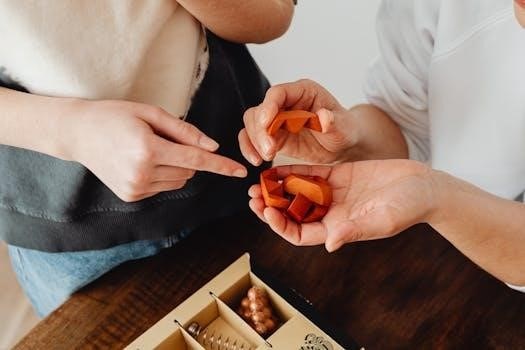Simon Swipe Game⁚ A Comprehensive Guide

Welcome to the ultimate guide for the Simon Swipe game! This modern twist on the classic Simon game challenges players with tapping, swiping, and reversing motions․ Get ready to test your memory and reflexes as you navigate through 16 levels of increasing difficulty․ This guide covers everything from the game’s objective to advanced strategies․
Simon Swipe represents a modern evolution of the beloved memory game, Simon, which first captivated audiences in 1976․ Building upon the foundation of its predecessor, Simon Swipe introduces touch screen technology, adding a new layer of challenge and engagement for players․ This updated version maintains the iconic colors, lights, and sounds that define the classic Simon experience․ However, it replaces the traditional button-pressing with intuitive tap and swipe gestures․
Simon Swipe offers a fast-paced, action-packed gameplay where participants must meticulously remember and replicate increasingly complex patterns․ Unlike the original, Simon Swipe incorporates unique swipe and reverse actions, demanding heightened concentration and dexterity․ With multiple game modes available, players can practice solo or compete against friends․ The game gradually escalates in difficulty, featuring 16 progressively challenging levels designed to push players’ memory and reflexes to their limits․
This modern interpretation of Simon provides a fresh and exciting way to experience a timeless classic, appealing to both nostalgic fans and new players alike․ Simon Swipe successfully blends the familiar elements of the original with innovative touch screen mechanics, creating a uniquely addictive and entertaining gaming experience․
Objective of the Game

The primary objective of Simon Swipe is to accurately replicate the sequences of light and sound combinations presented by the game․ Players must carefully observe the patterns and then reproduce them using taps, swipes, and reverse actions on the touch screen․ Each successful repetition adds another element to the sequence, progressively increasing the difficulty and testing the player’s memory and reaction time․
To achieve a high score, players must strive to complete as many sequences as possible without making errors․ The game continues until a player fails to correctly reproduce a pattern, at which point the game ends, and the player’s score is recorded․ Different game modes may introduce variations on this core objective, such as eliminating colors or competing against other players, but the fundamental goal remains the same⁚ to master the sequences and achieve the highest score possible․
Ultimately, the game challenges players to improve their memory, focus, and hand-eye coordination․ Through persistent practice and strategic gameplay, players can unlock new levels and achieve mastery over the Simon Swipe game․ The game’s blend of simple mechanics and increasing complexity ensures an engaging and rewarding experience for players of all skill levels․
Game Modes Overview

Simon Swipe offers a variety of engaging game modes to cater to different player preferences and skill levels․ Each mode presents a unique challenge and requires players to adapt their strategies for optimal performance․ One popular mode is the classic Simon Says, where players must replicate ever-increasing sequences of lights and sounds, testing their memory and reaction time․
Another mode, Player Adds, introduces a competitive element, allowing multiple players to take turns adding to the sequence․ This mode demands not only memory but also strategic thinking as players try to outsmart their opponents․ Simon Says Elimination adds a twist by eliminating colors as the game progresses, increasing the difficulty and requiring players to focus on the remaining options․
These diverse game modes ensure that Simon Swipe remains fresh and exciting, providing endless hours of entertainment․ Whether you prefer solo challenges or competitive multiplayer experiences, Simon Swipe has a game mode to suit your style․ By exploring each mode, players can discover their strengths and develop a comprehensive understanding of the game’s mechanics, ultimately enhancing their overall gameplay experience․
Basic Gameplay⁚ Taps and Swipes
The core gameplay of Simon Swipe revolves around two fundamental actions⁚ tapping and swiping․ Tapping is used when a single light illuminates, requiring the player to quickly and accurately touch the corresponding color․ This tests reaction time and precision, forming the foundation of the game’s challenge․
Swiping comes into play when two lights appear simultaneously․ In this case, the player must slide their finger across the screen, connecting the two illuminated colors in the correct sequence․ This introduces a spatial element, demanding coordination and awareness of the color arrangement․ Mastering both tapping and swiping is essential for progressing through the game’s levels․
The game starts with simple sequences, gradually increasing in complexity as the player advances․ This allows beginners to learn the basic mechanics before facing more challenging patterns․ By focusing on accuracy and speed, players can build a strong foundation in tapping and swiping, setting the stage for mastering the advanced moves and conquering the game’s toughest levels․ Understanding these core mechanics is crucial for any player looking to excel at Simon Swipe․
Advanced Moves⁚ Swipe and Reverse
Beyond the basic taps and swipes, Simon Swipe introduces advanced moves that demand greater dexterity and cognitive processing․ One such move is the “swipe and reverse,” which occurs when the lights move clockwise and then immediately go back in the opposite direction․ This requires the player to quickly adapt and change their swiping direction, adding a layer of complexity to the gameplay․
Mastering the swipe and reverse move is crucial for tackling the later levels of the game, where patterns become increasingly intricate and fast-paced․ Players must anticipate the change in direction and execute the reverse swipe with precision to avoid errors․ This advanced move tests not only reflexes but also the ability to recognize patterns and predict the game’s sequence․
Successfully executing the swipe and reverse requires practice and a keen understanding of the game’s mechanics․ Players must develop muscle memory and train their minds to react swiftly to the changing patterns․ By mastering this advanced move, players can unlock new levels of skill and conquer the most challenging sequences that Simon Swipe has to offer, proving their mastery of the game․
Scoring System
The Simon Swipe game features a scoring system designed to track and reward player progress․ Points are typically awarded for each correct sequence completed, with higher scores given for more complex patterns and faster response times․ As players advance through the levels, the scoring system may also incorporate bonus points for achieving milestones or completing challenges․
The game unit displays the player’s current score on an LCD screen, providing immediate feedback on their performance․ This allows players to monitor their progress and strive to improve their scores with each attempt․ Simon Swipe also records the high score achieved, motivating players to compete against themselves and others to reach the top of the leaderboard․
Furthermore, the scoring system may vary depending on the game mode selected․ Some modes may emphasize accuracy, while others prioritize speed․ Understanding the nuances of the scoring system in each mode is essential for maximizing points and achieving the highest possible score․ By mastering the scoring system, players can unlock new levels of competition and demonstrate their expertise in Simon Swipe․
Turning the Unit On and Off

To begin your Simon Swipe adventure, you’ll first need to power on the game unit․ Locate the power switch, typically found on the back of the device․ Slide the switch to the “GAME” position to activate the unit․ Once powered on, the unit will illuminate, indicating that it is ready for gameplay․ The LCD screen will display the main menu, presenting you with various game mode options․
When you’re finished playing, turning off the Simon Swipe unit is equally straightforward․ Simply slide the power switch back to the “OFF” position․ This will deactivate the unit, conserving battery life․ It’s essential to ensure the unit is fully powered down when not in use to prevent accidental activation and unnecessary battery drain․
Additionally, Simon Swipe may feature an automatic shut-off function․ If the unit remains inactive for a certain period, it will automatically power down to save energy․ This feature helps prolong battery life and ensures that the unit is always ready for your next gaming session․ Remember to turn off the unit manually if you plan to store it for an extended period․
Selecting a Game Mode
Once your Simon Swipe unit is powered on, you’ll be greeted by the main menu, which displays the available game modes․ Navigating through these options is typically done using the illuminated lenses or designated buttons on the unit․ Each lens corresponds to a specific game mode, offering a unique challenge and gameplay experience․
To select a game mode, simply press the corresponding lens or button․ The unit will then highlight your selection, confirming your choice․ Simon Swipe offers four distinct game modes․ These modes include Simon Says, Player Adds, Simon Says Elimination, and possibly other variations․ Experimenting with each mode will allow you to discover your preferred style of play․
The Simon Says mode presents the classic Simon challenge, requiring you to memorize and repeat increasingly complex sequences․ Player Adds introduces a competitive element, where players take turns adding to the sequence․ Simon Says Elimination adds another layer of difficulty․ Be sure to consult the game guide for detailed instructions․
High Score Recording
Simon Swipe is designed to track and record your highest scores, motivating you to improve your skills and beat your personal best․ After completing a game, the unit automatically calculates your score based on factors such as the number of correct sequences completed and the level of difficulty reached․ This score is then displayed on the unit’s screen, providing immediate feedback on your performance․
The game features a built-in memory system that stores your highest score for each game mode․ This allows you to compare your current performance against your previous achievements, fostering a sense of progress and accomplishment․ To view your high scores, navigate to the designated high score menu, typically accessible through a button or lens selection on the unit․
The high score display usually shows your name or a player ID alongside the corresponding score, enabling you to track your progress over time․ Competing against your own high scores adds an extra layer of engagement to the game․ You can challenge yourself to consistently improve your memory and reaction time․ Simon Swipe’s high score recording feature transforms a simple game into a personal challenge․
Troubleshooting and Tips
Encountering issues with your Simon Swipe game? Here are some common problems and helpful tips․ If the unit doesn’t turn on, first check the batteries․ Ensure they are inserted correctly, matching the positive (+) and negative (-) polarity markings․ Replace the batteries with fresh ones if needed․ If the game freezes or behaves erratically, try turning it off and on again to reset the system․
For swipe recognition problems, make sure your fingers are clean and dry․ Avoid touching the outer ring of the unit while playing, as this can interfere with the touch sensors․ Practice your tapping and swiping techniques to improve accuracy and speed․ When attempting advanced moves like swipe and reverse, focus on the direction of the lights to prevent errors․
To maximize your score, concentrate on memorizing the sequences and reacting quickly․ Familiarize yourself with the unique challenges of each game mode․ If you are still having problems, consult the game guide for additional troubleshooting steps and solutions․ Remember, practice makes perfect, so don’t give up!
